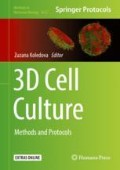Abstract
This protocol describes detailed practical procedures for generating 3D intact and perfusable microvascular network that connects to microfluidic channels without appreciable leakage. This advanced 3D microvascular network model incorporates different stages of vascular development including vasculogenesis, endothelial cell (EC) lining, sprouting angiogenesis, and anastomosis in sequential order. The capillary network is first induced via vasculogenesis in a middle tissue chamber and then EC linings along the microfluidic channel on either side serve as artery and vein. The anastomosis is then induced by sprouting angiogenesis to facilitate tight interconnection between the artery/vein and the capillary network. This versatile device design and its robust construction methodology establish a physiological microcirculation transport model of interconnected perfused vessels from artery to vascularized tissue to vein.
* These authors contributed equally to this work.
Access this chapter
Tax calculation will be finalised at checkout
Purchases are for personal use only
References
Lee H, Chung M, Jeon NL (2014) Microvasculature: an essential component for organ-on-chip systems. MRS Bull 39(1):51–59
Schimek K, Busek M, Brincker S et al (2013) Integrating biological vasculature into a multi-organ-chip microsystem. Lab Chip 13(18):3588–3598
Hasan A, Paul A, Vrana NE et al (2014) Microfluidic techniques for development of 3D vascularized tissue. Biomaterials 35(26):7308–7325
Esch MB, Post DJ, Shuler ML et al (2011) Characterization of in vitro endothelial linings grown within microfluidic channels. Tissue Eng A 17(23–24):2965–2971
Bischel LL, Young EWK, Mader BR et al (2013) Tubeless microfluidic angiogenesis assay with three-dimensional endothelial-lined microvessels. Biomaterials 34(5):1471–1477
Booth R, Noh S, Kim H (2014) A multiple-channel, multiple-assay platform for characterization of full-range shear stress effects on vascular endothelial cells. Lab Chip 14(11):1880–1890
Lee H, Kim S, Chung M et al (2014) A bioengineered array of 3D microvessels for vascular permeability assay. Microvasc Res 91:90–98
Kim S, Lee H, Chung M et al (2013) Engineering of functional, perfusable 3D microvascular networks on a chip. Lab Chip 13(8):1489–1500
Yeon JH, Ryu HR, Chung M et al (2012) In vitro formation and characterization of a perfusable three-dimensional tubular capillary network in microfluidic devices. Lab Chip 12(16):2815–2822
Vickerman V, Blundo J, Chung S et al (2008) Design, fabrication and implementation of a novel multi-parameter control microfluidic platform for three-dimensional cell culture and real-time imaging. Lab Chip 8(9):1468–1477
Young EWK (2013) Advances in microfluidic cell culture systems for studying angiogenesis. J Lab Autom 18(6):427–436
Chiu LL, Montgomery M, Liang Y et al (2012) Perfusable branching microvessel bed for vascularization of engineered tissues. Proc Nat Acad Sci U S A 109(50):E3414–E3423
Whisler JA, Chen MB, Kamm RD (2014) Control of perfusable microvascular network morphology using a multiculture microfluidic system. Tissue Eng 20(7):543–552
Diaz-Santana A, Shan M, Stroock AD (2015) Endothelial cell dynamics during anastomosis in vitro. Integr Biol 7(4):454–466
Chan CY, Huang PH, Guo F et al (2013) Accelerating drug discovery via organs-on-chips. Lab Chip 13(24):4697–4710
Bhatia SN, Ingber DE (2014) Microfluidic organs-on-chips. Nat Biotechnol 32(8):760–772
Huh D, Torisawa YS, Hamilton GA et al (2012) Microengineered physiological biomimicry: organs-on-chips. Lab Chip 12(12):2156–2164
Hsu YH, Moya ML, Hughes CCW et al (2013) Full range physiological mass transport control in 3D tissue cultures. Lab Chip 13(1):81–89
Hsu YH, Moya ML, Hughes CCW et al (2013) A microfluidic platform for generating large-scale nearly identical human microphysiological system arrays. Lab Chip 13(15):2990–2998
Moya ML, Hsu YH, Lee AP et al (2013) In vitro perfused human capillary networks. Tissue Eng Part C Methods 19(9):730–737
Wang X, Phan DTT, Sobrino A et al (2016) Engineering anastomosis between living capillary networks and endothelial cell-lined microfluidic channels. Lab Chip 16(2):282–290
Wang X, Phan DTT, Zhao D et al (2016) An on-chip microfluidic pressure regulator that facilitates reproducible loading of cells and hydrogels into microphysiological system platforms. Lab Chip 16(5):868–876
Acknowledgments
This work was supported by grants from the National Institutes of Health: UH3 TR00048 and PQD5 CA180122. C.C.W.H. receives support from the Chao Family Comprehensive Cancer Center (CFCCC) through an NCI Center Grant award P30A062203. X.W. receives support from National Natural Science Foundation of China (No. 31600781). We would also like to thank the permission of The Royal Society of Chemistry (RSC) for reproduction of materials from Lab on a Chip journal.
Author information
Authors and Affiliations
Corresponding authors
Editor information
Editors and Affiliations
Rights and permissions
Copyright information
© 2017 Springer Science+Business Media LLC
About this protocol
Cite this protocol
Wang, X., Phan, D.T.T., George, S.C., Hughes, C.C.W., Lee, A.P. (2017). 3D Anastomosed Microvascular Network Model with Living Capillary Networks and Endothelial Cell-Lined Microfluidic Channels. In: Koledova, Z. (eds) 3D Cell Culture. Methods in Molecular Biology, vol 1612. Humana Press, New York, NY. https://doi.org/10.1007/978-1-4939-7021-6_24
Download citation
DOI: https://doi.org/10.1007/978-1-4939-7021-6_24
Published:
Publisher Name: Humana Press, New York, NY
Print ISBN: 978-1-4939-7019-3
Online ISBN: 978-1-4939-7021-6
eBook Packages: Springer Protocols

